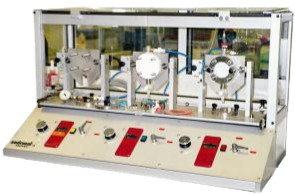
NewsInformation Center
How to use the moisture resistance microbial penetration tester correctly?
2022/09/20
The moisture barrier microbial penetration tester is suitable for evaluating the performance of materials that penetrate bacteria in mechanical friction liquids, especially to determine the performance of materials that block bacteria penetration in liquids during mechanical friction. It is mainly used for medical surgery checklists, Surgical gowns, cleaning gowns, etc.
Test principle:
Put the test piece on the agar petri dish, place the same specification of bacterial slices on the test piece, then cover it with about 10 microns thick high-density polyethylene film, and use a tapered steel ring to seal the three-layer material (the test material is below, The bacterial sheet is in the middle, the high-density polyethylene film is on the top), and the ring is placed on the agar petri dish on the turntable. The test refers to the combination of pressure and friction on the entire petri dish surface. to simulate the possible stress and microbial penetration of the barrier material under wet conditions during practical applications. The microbial penetration test material on the bacterial plate will migrate to the surface of the agar medium. The permeability of the test material can be quantitatively assessed by counting cultures and colonies on agar plates.

Instrument parameters:
1. Turntable speed 60rpm±1rpm.
2. The test refers to the material pressure of 3N±0.02N.
3. The rotation speed of the outward wheel is 5~6rpm.
4. The timer setting range is 0~9999min.
5. Total weight of inner ring and outer ring: 800g±1g.
Moisture resistance microbial penetration test process:
Preparation of bacterial tablets
Staphylococcus aureus ATC29213 was incubated at 36°C ± 1°C for 18-24 hours, 2-3 colonies at 36°C ± 1°C, and 18-24 hours at 36°C ± 1°C. Dilute with protein water 1:10 to a concentration of 1×104CFU/ml~4×104CFU/ml, and calculate * dead bacteria suspension.
Open the sterile bag, remove the polyurethane film still attached to the IQ, and place the soakable polyurethane film side up on a clean plate. For ease of handling, secure the four corners of the fungal material sheet to the plate with double-sided tape. Using the Petri dish lid as a template, apply 1.0 ml of the S. aureus suspension to the area, then dry at 56°C for about 30 min. During drying, continue to apply the bacterial suspension to the bacterial film using a sterile glass coater to distribute the bacterial liquid evenly.
Previous: What are the color fastness test items for printed and dyed textiles?
N e x t : What are the main parts of the mask particle filtration tester?



